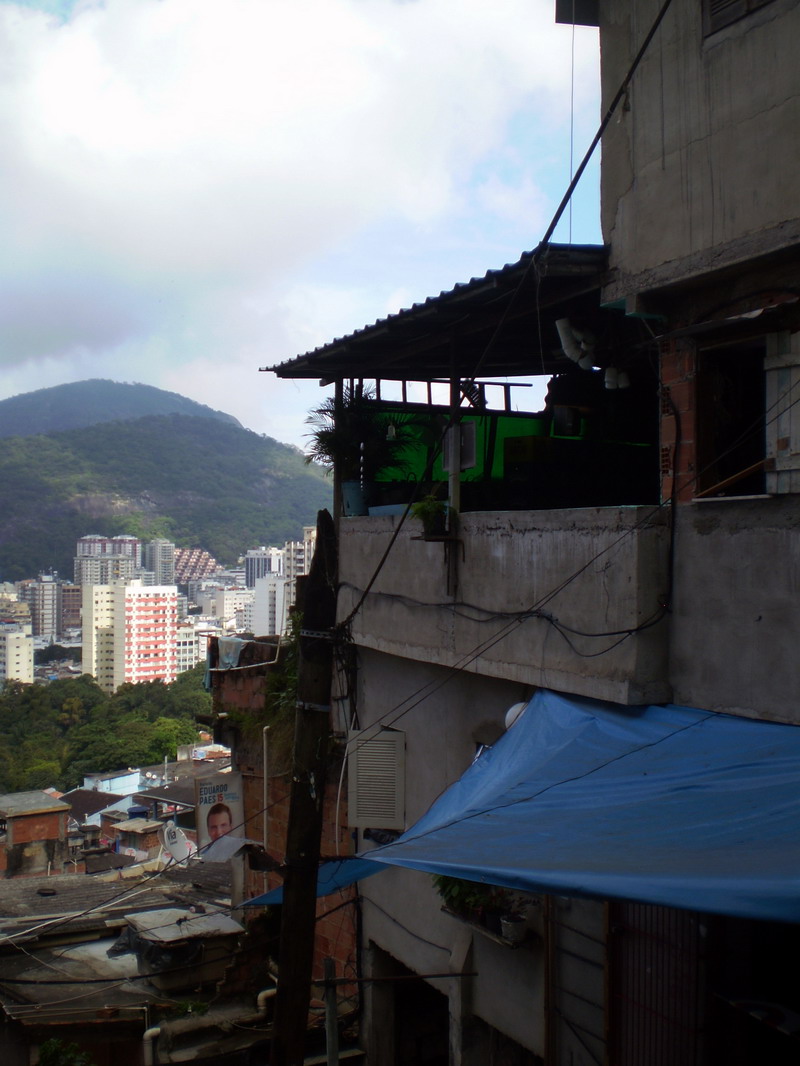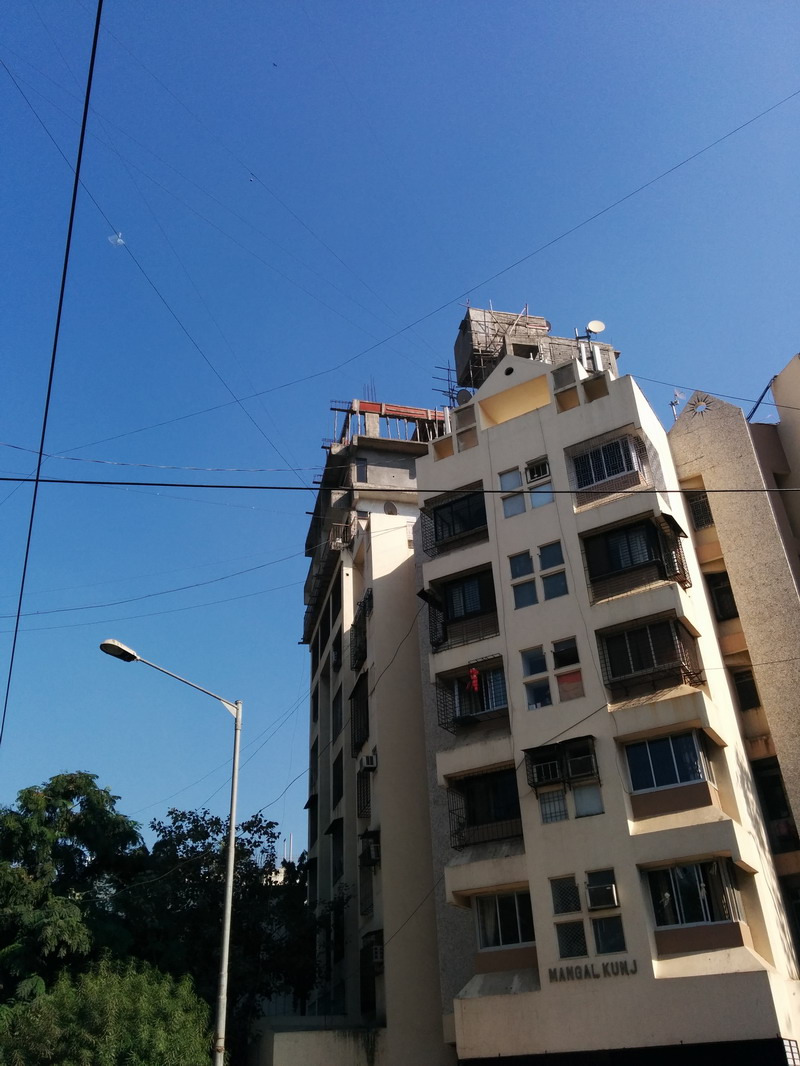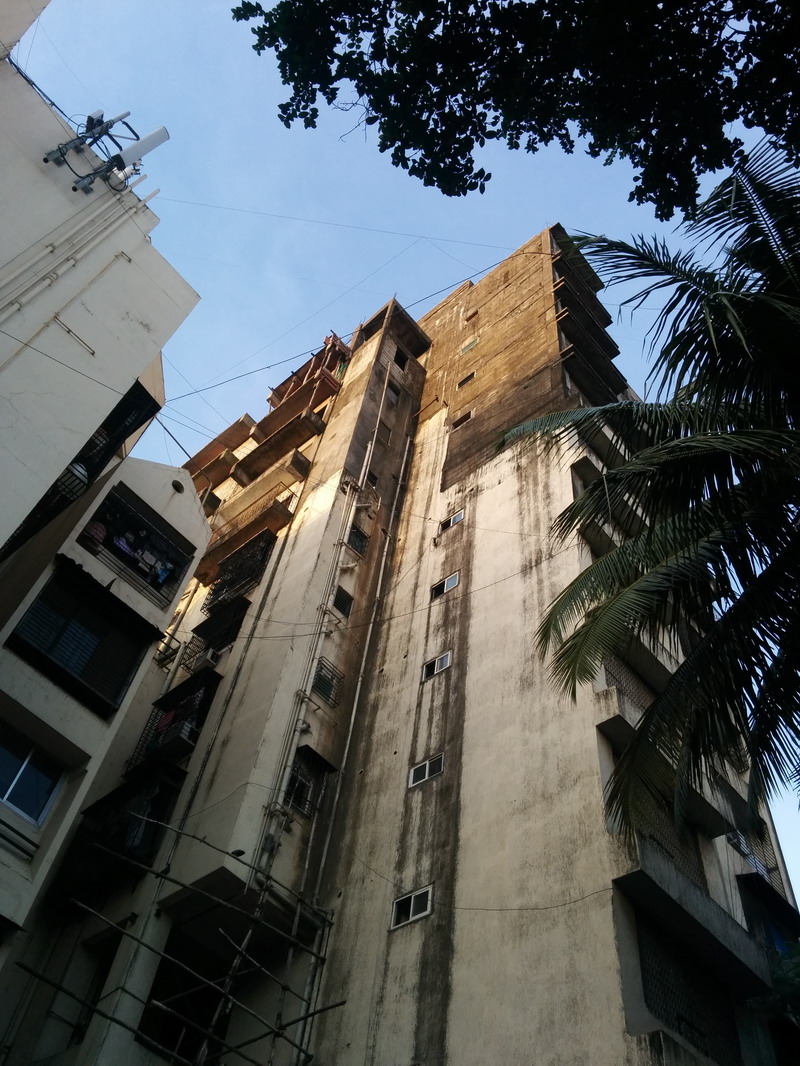“Village-cities,” Usme – Bogotá, Colombia. Image © Laura Amaya
| William Oquendo的房子建在波哥大的一座山上,因为海拔较高,所以云雾缭绕。其内部门窗众多,流线混乱,像迷宫一样,比如打开卧室的门就到了厨房,浴室朝着客厅开放。
五千公里外的里约热内卢,Gilson Fumaça住在一栋三层高的房子里。这栋房子由他祖父建造,他父亲改造,最后传到他手里。房子至今仍然十分坚固,一层由砖和水泥砂浆砌成,二层用混凝土打造,三层则是由镀锌的面砖以及零散的砖瓦随意组合而成。第三层是在Gilson Fumaça的收入增加以后改造的。
然而,位于世界另一边的孟买,由于铁路轨道的铺建,无数的民居面临着拆迁,破坏,然后又重建的局面。“城市在不断的改变”---- Suketu Mehta在《极大之城》中提出。很多家庭都住在人行道旁或者天桥下面用竹子和塑料袋搭建的棚屋内,而这种他们自己用简易材料搭建的棚屋面临着随时倒塌的危险。然而达拉维(据说是亚洲最大的贫民窟)却有着更好的居住条件,他们有相对坚固的房子,通水电,并且有对土地的使用权,但是多数的移民无法获得这种待遇。
Perched behind the fog that conceals Bogotá’s mountains is William Oquendo’s house. It is a labyrinth of doors and windows, wherein a bedroom opens into the kitchen and a bathroom vents out into the living room.
Five thousand 5,000 kilometers away in Rio de Janeiro, Gilson Fumaça lives on the terrace level of a three-story house built by his grandfather, his father, and now himself. It’s sturdy; made out of brick and mortar on the ground floor, concrete on the second, and a haphazard combination of zinc roof tiles and loose bricks on the third. The last is Gilson’s contribution, which he will improve as his income level rises.
On the other side of the world in Bombay (Mumbai since 1995), houses encroach on the railway tracks, built and rebuilt after innumerable demolition efforts. “The physical landscape of the city is in perpetual motion,” Suketu Mehta observes in ‘Maximum City.’ Shacks)are built out of bamboo sticks and plastic bags; families live on sidewalks and under flyovers in precarious homes constructed with their hands. And while Dharavi—reportedly the largest slum in Asia—has better quality housing, running water, electricity and secure land tenure, this is not the case for most of the new migrants into the city.
| |

View from William Oquendo’s house, Barrio El Dorado – Bogotá, Colombia. Image © Laura Amaya
| 随着印度人口大范围的从农村迁到城镇,孟买正在经历一场城镇化的大浪潮。对大量涌入的农村人口的安置问题,孟买决定效仿拉丁美洲的解决方式,建造城市贫民窟,这个方法经过了数代的发展,已较为成熟。但是相比较波哥大的4600人/平方千米和里约热内卢的5200人/平方千米的人口密度,孟买20000人/平方千米的人口密度显然是计划推行的障碍,这就需要在借鉴波哥大和里约热内卢的经验的同时采用创新的方式推行计划。就像Mehta说的:“这里没有足够的空间保证每个人立刻有房子居住,除非他们保持在睡眠状态,并且尽可能少地翻身。”
在一个城镇化少于30%的国家,孟买为每一个迁入城市的农村人口提供住所,并且对农村进行改造。自然而然地,每一个非正式居住点都形成了社区,这是对每个居住在内的居民最有利的方式。社区予以居民庇护,是聚居在一起的人们为了相互扶持自发形成的,而不是政府的意愿。同时考虑到新迁入的居民还没有办法适应城市快节奏的生活,这些区域反而近似于农村——这些贫民窟就是城市中的农村 。
Bombay has experienced a recent wave of mass urbanization as India’s population shifts from rural to urban. New settlements in Mumbai are set to follow the same course as Latin American slums, which have grown throughout generations. However, the city’s density—20,000 people per square kilometer as compared to Bogotá’s 4,600 or Rio de Janeiro’s 5,200—will require an innovative form of progressive development. As Mehta notes, “there isn’t enough space for everyone to be in a house at once, except when they’re all sleeping, and body movements are kept to a minimum.”
In a country that is less than 30 percent urban, Bombay provides a home to villagers who move into the city and recreate the village. Inevitably then, community is the greatest asset of informal settlements. It provides a safety net for vulnerable populations, which does not depend on the willingness of government but on a self-regulated mechanism of mutual support. And, given that the incoming urban dwellers have not yet caught up with the speed of the city’s transformation, it is the closest link to the village—the slum is the village within the city.
| |

Gilson Fumaça’s house, Favela Santa Marta – Rio de Janeiro, Brazil. Image © Laura Amaya
| 另一个方面,波哥大如很多南美城市一般正在经历城市化的大浪潮,伴随而来的是大量的城市移民和盛兴的违章建筑群。在短时间飙升的城市人口造成了城市服务系统的巨大压力。非正式居住点的盛兴临时减轻了城市的住房压力,直到今天,拉丁美洲每五个城市居民中仍有一个是居住在贫民窟的。然而他们中有很多人的居住已经从最初的非法聚居到如今的城市社区组织,进而慢慢融入城市当中。
南美和南亚很对城市的城镇化是依靠时间和金钱推动的,而并非自然发展而成的。而这些农村移民也从最初的占屋者发展成为城镇化的建设者,他们已经非常适应城市社区的发展,并且可以对社区的需求做出最快的回应。
Bogotá on the other hand—like most South American cities—experienced urban growth with the highest wave of rural migrants settling in what were then emerging squatter settlements. Soaring numbers of new urban dwellers in such a short period posed the challenge of providing adequate services. Informal settlements flourished and temporarily alleviated the housing crisis, yet still today one out of every five urban residents in Latin America live in favelas, invasiones or barrios, as they are locally known. Initially illegal and quite precarious, many of them have gradually become consolidated communities successfully incorporated into the urban fabric.
Stemming from the informal nature of the development of cities, urban transformation in South America and South Asia is a process entirely dependent on time and money. From squatters to township developers cities grow progressively, responding and always adjusting to the immediate needs of a community.
| |

Mangal Kunj residentail building before the construction of the upper floors. Bandra (W) – Mumbai, India. Image © Laura Amaya
| 当我刚到孟买的时候,我搬进了班德拉郊区的一栋居民楼,Mangal Kunj的顶层。这栋房子建成不到10年,我们租下了顶层的公寓。楼里的电梯按钮一共到12层,但是实际上楼层只有8层,我们还猜想,这部电梯可能是议价购买的。有一天早晨,我急匆匆地出门开始我漫长的通勤,这时候电梯的电子屏居然显示数字“9”。很快,建筑工人运来水泥和砖开始在屋顶作业。三个月以后,Mangal Kunj的顶层公寓被夹在原建筑和新建的第九、十、十一、十二层之间了。
When I first landed in Mumbai I moved into the top floor of Mangal Kunj, a building in the upmarket suburb of Bandra. We rented the penthouse apartment of a fairly new building that was no more than ten years old. The elevator had buttons to a twelfth floor and we assumed that it must have been purchased at a bargain price, given there were only eight floors. One morning, as I rushed out to start the lengthy commute, the elevator screen read “9”. Soon enough, contractors pounded on the roof bringing up bags of cement and shipments of brick. Three months later, the former penthouse of Mangal Kunj is sandwiched between the original building downstairs and the construction work that leads up to the ninth, tenth, eleventh, and twelfth stories.
| |

Mangal Kunj residentail building after the construction of the upper floors. Bandra (W) – Mumbai, India. Image © Laura Amaya
| 同样的情况也出现在新德里阿育王大学,这是一所伊顿的文科大学。分期段建设要求建筑在设计时有阶段性的考虑和不同的打算,这不仅体现在学术功能和行政管理功能的无缝连接上,而且要考虑到建筑在将来会越增越高。一栋现在6层高的建筑可能在5年后增至12层高。
“乡村——城镇”的文化,快速的城镇化以及共享的经济形态正在持续发展中,随之而来的是为了适应这样的发展而不断产生的变化。William的房子很快会有它的第四层,Gilson Fumaça会加固房子的第三层为日后在其基础上增建做准备。孟买贫民窟的居民将用面砖代替塑料屋顶,用砖墙代替竹子。其他像Mangal Kunj的建筑很快会有它们的第十四层和第十五层。在波哥大到处可见建筑顶层外挑的螺纹钢筋,这表明房主随时准备在原有房子的基础上增建新的楼层,可能因为家里有孩子出生,也可能因为家庭成员的增加。
A similar instance of progressive development happens in New Delhi at Ashoka University, an Ivy League-style liberal arts college. Phased construction requires buildings to be planned in stages and for different purposes. Not only must they seamlessly adapt from academic to administrative use, but they will also grow taller throughout time. A building today will have six stories; five years later it will have twelve.
The culture of ‘village-cities’, the rapid urbanization, and the sharing economy make it so that there is constant adaptation. William’s house will soon have a fourth story, and Gilson Fumaça will consolidate the third floor of his favela home, making way for a new terrace level above. Mumbai slum dwellers will substitute plastic roofs for firm tiles and replace bamboo sticks with brick walls. Other buildings like Mangal Kunj will construct their fourteenth and fifteenth stories, while Bogotá will continue to see steel rebars protruding out of the tops of houses, ready to rise another level with the birth of a child or after the promotion of a family member.
| |

Mangal Kunj residentail building, Bandra (W) – Mumbai, India. Image © Laura Amaya
| 纽约和伦敦可以为任何在城市中迁移的人们提供住处,这些人已经十分适应城市的生活,然而波哥大和孟买是仍然处在城市化进程中的城市,并没有发展完全。它们正处在从乡村到大都市转变的初步过渡阶段,但是,不可否认的是,这是一个巨大的飞跃。很多家庭从农田劳作迁移到城市的棚屋中,并从那里一步步走向中产阶级,从Jogeshwari到Mira Road(孟买),从Cazucá到Nuevo Usme(波哥大),位于地球两个不同半球的人们已经逐渐开始适应城市的新生活了。
城镇化的浪潮正在席卷全球,建筑要满足随之而来的不断改革的需求。计意味着对背景的更广泛的了解,超越了对审美思考和直接的空间关系。它使人和空间之间有了更亲密的互动,并且是对复杂城市问题朴实无华的回应。我们可以从城市自然发展的进程中学到很多,例如波哥大和孟买,最重要的是要知道其本质上的改变,对于这种改变不要去阻止它而是要补足它。
While New York and London house the people that move from city to city, all acquainted with the etiquette)of an urban lifestyle, Bogotá and Bombay are cities of villagers on the road to urbanization. They serve as an initial step in the transition between the countryside and the metropolis; undeniably the most drastic leap. Families move from the fields to the shacks, and from there to middle-class neighborhoods; from Jogeshwari to Mira Road (Mumbai), and from Cazucá to Nuevo Usme (Bogotá), people on opposite sides of the planet gradually embrace a new way of living.
As village-cities evolve into global cities, architecture must cater to the need for continuous reinvention. Design is a broader understanding of a context, beyond aesthetic considerations and immediate spatial relationships. It is the intimate relation between people and place; an unpretentious response to complex urban problems. A lesson can be learned from the nature of progressive development in cities like Bogotá and Bombay; it is essential to acknowledge intrinsic change and not counter but complement it.
References(参考文献)
[1] Mehta, Suketu. Maximum City : Bombay Lost and Found. New York: Alfred A. Knopf, 2004: 137.
[2] (a) Anuário Estatístico Do Estado Do Rio De Janeiro. Rio de Janeiro, RJ: O Centro, 2010. DVD; (b) Alcaldía Mayor de Bogotá DC, Mapa de Bogotá – Atlas, http://mapas.bogota. gov.co/atlas/visor/index.html (accessed April 2012); (c) Ministry of Home Affairs – Office of the Registrar General and Census Commissioner, India, Census of India 2011, http://www.censusindia.gov.in/pca/default.aspx (accessed August 2014).
[3] Mehta, Suketu. Maximum City : Bombay Lost and Found, 488.
[4] Mehta, Suketu. Maximum City : Bombay Lost and Found, 549.
[5] UN-HABITAT, State of the World’s Cities 2010/2011: Bridging the Urban Divide (London: Earthscan, 2010): 44.
| |
| 出处:本文译自www.archdaily.com/,转载请注明出处。
编辑:范偲慧,汁汁
| |
|
|
